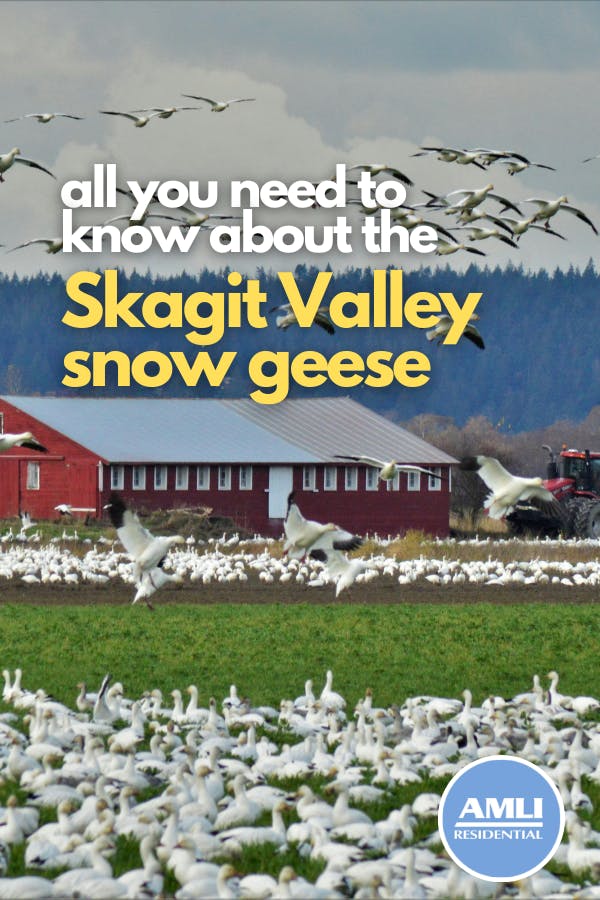If you’ve driven through Skagit Valley at all during the winter and early spring months, then you’ve undoubtedly seen the oceans of white birds covering fields and wetlands all over the valley.
These are the Skagit Valley snow geese, and they’re an annual sight here in Washington among the many wintering birds that travel here during the migratory winter months.
Here’s all you need to know about these beautiful birds that, for better or worse, are increasing in population each and every year!
Why do snow geese migrate to Skagit Valley?
What are snow geese?
Snow geese are medium-sized birds known for their stunning plumage and magnificent migration patterns. They come in two color varieties: the classic "snow" form, boasting a gleaming white body with contrasting black wingtips, and the aptly named "blue" variety, featuring a dark grayish-blue body with a white head and neck.
Honestly, you can’t miss them. Especially because they come in groups of, like, a thousand at a time.
Standing around two and a half feet tall with a wingspan exceeding four feet, snow geese are impressive fliers that navigate long migrations in large, noisy flocks. These social birds are often seen in tight-knit family groups, and their synchronized movements during flight create a mesmerizing spectacle — especially when predatory birds swoop overhead and startle the flock to take flight.
Where do the snow geese migrate to?
Snow geese start their migrations at Wrangel Island, a remote landmass in the Chukchi Sea north of Siberia and well into the high latitudes of the Arctic Circle. The island’s vast tundra landscapes and abundant freshwater wetlands provide the ideal living conditions for a wide variety of animals, from polar bears to buffalo to Pacific Walrus, birds, whales and more. Even the list of plant species discovered in this remote island has already hit 417 and is still climbing!
For many migrating species such as the gray whale (which migrates to and from Mexico each year!) and our very own snow geese, the island offers ideal conditions for bearing and raising their young. Come late August, however, as the harsh Arctic winter approaches, the snow geese embark on a southward migration, a journey that these feathery fellows have been making for millennia.
Traditionally, the Pacific Flyway served as the primary route for Wrangel Island snow geese heading to and from Wrangel Island. This aerial highway stretches from northern Siberia down the Alaskan coast and down the west coast of North America, with California's Central Valley historically being the favored wintering destination. Research suggests that in the past, 80-90% of Wrangel Island snow geese would make a stopover in Washington's Skagit Valley before continuing south.
However, the pattern of snow geese migration has taken an interesting turn in recent decades. The population on Wrangel Island has boomed, rising from around 50,000 in the 1970s to well over 300,000 today. This dramatic increase has coincided with a shift in migration patterns. Today, an estimated 60% of Wrangel Island snow geese choose to forgo the long flight to California altogether, opting instead to spend their entire winter in the Skagit Valley and neighboring Fraser Valley in British Columbia.
Several factors are believed to be driving this change. The shorter distance to the Skagit Valley compared to California's Central Valley translates into less energy expenditure for the geese. Additionally, the abundant farmlands in the region provide a new food source – leftover crops like potatoes, fruits and corn. This dietary adaptation, coupled with the milder winters of the Salish Sea, appears to be contributing to the geese's reproductive success in the Skagit Valley.
What does this mean for us birdwatchers? Well, like most times of change, there are pros and cons.
The arrival of the snow geese in Washington is a much-anticipated event, and has been for decades. Their dazzling white forms blanketing the fields and the cacophony of their calls create a truly awe-inspiring spectacle that’s great for any Instagram post or photoshoot background. Birdwatchers and nature enthusiasts flock to the Skagit Valley to witness this natural wonder, and local festivals celebrate the arrival of these feathered visitors. Then, at the end of winter when they all leave to return to the Arctic, clouds of flapping wings and honks rise from the plains and take off toward the north. It really is very, very cool.
However, the increasing snow goose population also presents challenges. Their grazing can be detrimental to agricultural fields, and their droppings can pose health risks when concentrated in such large quantities on food crop fields. Their increased population is linked to more stringent hunting rules, an increase in deforested land and conservation efforts that brought them back from low numbers, but the delicate ecosystems in the remote Siberian islands are also suffering due to increased strain on the natural resources.
Finding a balance between appreciating these magnificent creatures and minimizing their impact on our environment is crucial. There’s not much we can do about their presence here, but knowing more about how climate change, deforestation and conservation efforts can affect our foods, lands and resources through something as natural as a bird migration is part of our duty as stewards of the land!
Ultimately, the snow goose migration is a reminder of the interconnectedness of our planet. These remarkable birds travel vast distances across oceans and continents, adapting to changing conditions and only looking for the best places to raise their young and stay alive. By understanding and appreciating the presence of these snow geese and by understanding the roles we play in their impact on the land, we can ensure that future generations can continue to witness this breathtaking natural phenomenon in a world that, hopefully, is a little greener and kinder than it is today!
Where to see the snow geese in Skagit Valley
We can’t hype up these geese without giving you some bona-fide spots to go check them out, can we?
Snow geese travel in large flocks and, as such, need large spaces with ample food to rest for the winter. Look for open fields, wetlands, estuaries and meadows for these feathery travelers, and if you find them, watch them from a distance and do your best to not bother them.
Here are some good places to look for snow geese between September and April.
- Port Susan Bay Preserve
- Padilla Bay NERR & Breazeale Interpretive Center
- Padilla Bay Shore Trail
- North Fork Access
- Jensen Access
- Fir Island Farms Reserve Wildlife Area
- Skagit Bay Estuary Wildlife Area
- Skagit Bay Estuary, WDFW Water Access Site
- Mount Vernon country roads
- Use the eBird app for latest sightings
If you’re in Seattle or near our luxury Seattle apartments, then head up to the Skagit Valley this spring to experience the snow geese in all their glory up close and personal! There’s nothing else quite like it in the state, and you’ll only have a few more weeks before the birds take off for their remote Arctic island once again.
Have fun!
Pin it!

Featured photo by Bryan Hanson on Unsplash


 View All Posts by Colleen Ford
View All Posts by Colleen Ford